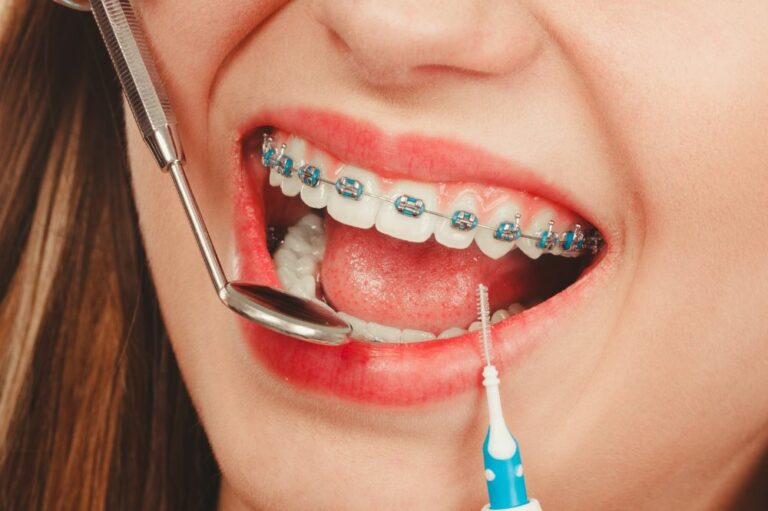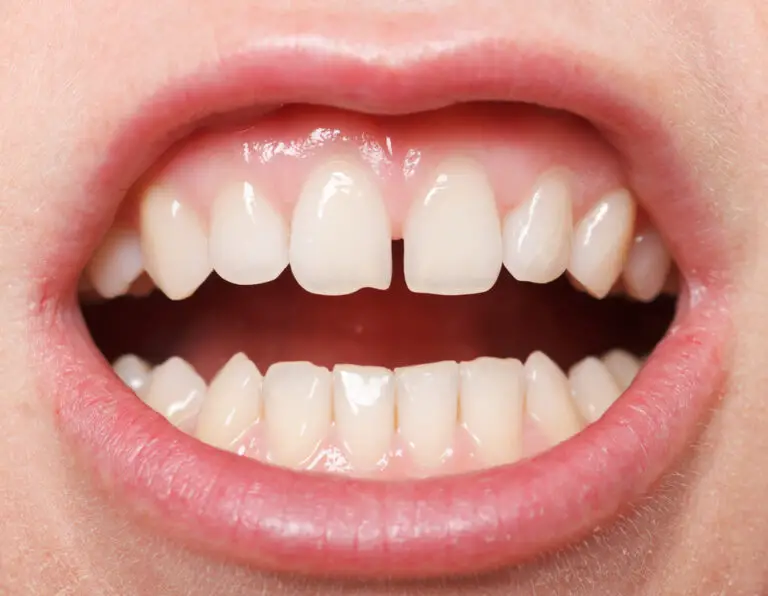Noticing that the teeth are beginning to turn black, especially in the spaces between them, can certainly be alarming. However, several potential causes exist for tooth discoloration of this nature. The reasons range from relatively benign dietary habits to more concerning dental diseases. Taking the time to understand the various factors that can lead to blackened areas on teeth is important. It allows one to determine whether professional dental evaluation and possible treatment may be warranted.
Main Causes of Blackened Regions Between Teeth
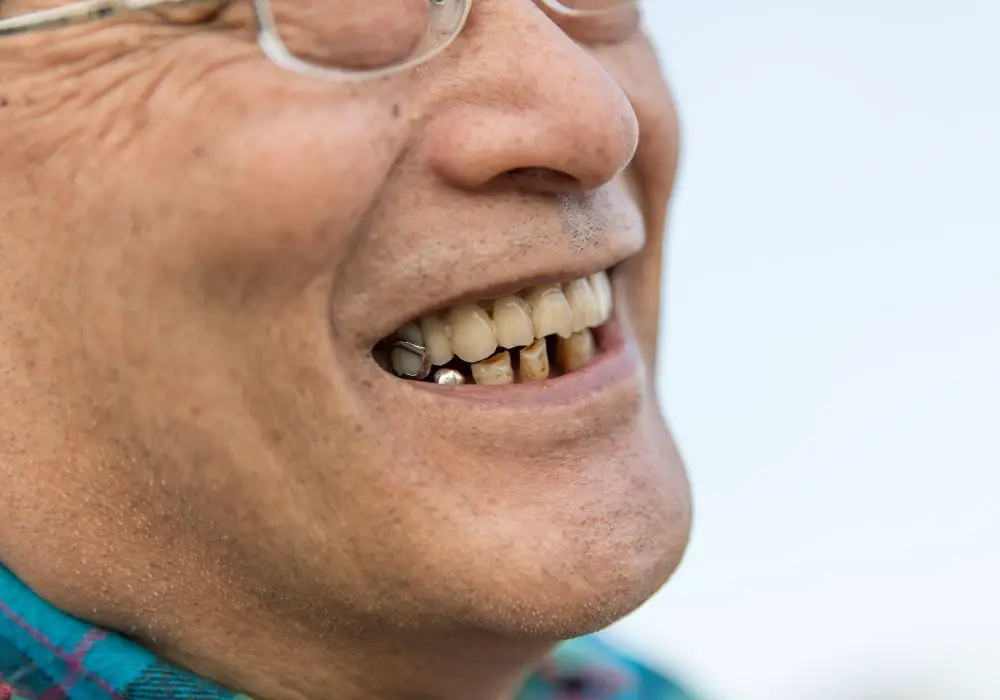
Teeth turning dark in color, particularly between them, stems from a number of sources. Here is more detail on the most common causative factors:
Food and Beverage Staining
Many foods and drinks are notorious for causing stubborn stains on dental surfaces. Some of the worst offenders include:
- Coffee – The deep brown liquid combined with dark roasted coffee particles easily permeate dental enamel. Over time, this leads to yellowish to brown deposits between teeth.
- Tea – Black and herbal teas contain tannins that impart a blackish/grey stained appearance on contact with teeth. Green tea can also stain due to its catechin content.
- Red wine – The deep red anthocyanins in wine stick to enamel, sinking into microscopic pits and fissures. This leads to grey, purple, or black accumulated discoloration between teeth.
- Cola drinks – In addition to sugars that erode enamel, colas contain caramel coloring that deeply stains tooth surfaces. The phosphoric acid also roughens the enamel to allow more stain adhesion between teeth.
- Pomegranate juice – This trendy fruit juice leaves teeth vulnerable to staining due to its polyphenol compounds like anthocyanins and ellagitannins.
- Blueberries – The antioxidant compounds that give blueberries their vivid color also latch onto dental enamel readily. Over time, this can cause buildup of grey/black stains.
- Soy sauce – A dark pigment called ethylvanillin in soy sauce sticks to tooth surfaces. Frequent consumption allows stains to accumulate between teeth.
- Balsamic vinegar – This vinegar’s dark color comes from prolonged aging in barrels, forming pigments that tenaciously grip to enamel.
With habitual consumption of staining foods and drinks, the accumulation of pigmented deposits between teeth becomes more prominent. Minimizing frequency and swishing/rinsing after eating these items helps reduce staining.
Tobacco Use
Smoking cigarettes, cigars, pipes, chewing tobacco, or other forms of tobacco is infamous for causing significant tooth discoloration. When tobacco smoke or chew products contact the teeth, the tar and nicotine leads to yellowish-brown buildup. This stained material then wedges into openings along the gumline and between teeth. Continued use worsens the accumulated staining effect.
Smokeless tobacco placed chronically against the gums further promotes black line staining at the gum margins as the products leach out onto the enamel surface. Even electronic cigarette vapor leaves a film on the teeth that allows stains to adhere more readily. Thus, avoiding tobacco altogether is ideal to prevent greyish-black deposits between teeth due to use.
Poor Oral Hygiene
Insufficient brushing and flossing of the teeth allows plaque to build up rapidly. This plaque contains millions of oral bacteria in a sticky biofilm matrix. As the plaque thickens, the bacteria produce stains within this film through metabolic byproducts. These stained bacterial compounds then permeate into any tiny openings, cracks, or spaces between the teeth.
Within just 24-48 hours without brushing and flossing, noticeable yellowish to brownish plaque stains appear on the teeth. This can quickly progress to blackened areas if oral hygiene is not improved. Establishing a routine of brushing twice a day for 2 minutes plus daily flossing helps minimize staining from plaque accumulation between teeth.
Dental Trauma
Injury to the teeth, even if seemingly minor, can impact the enamel layer. Cracks or chips in the enamel expose the inner yellowish dentin layer of the teeth. This allows stains to more readily seep into the deeper structures.
As stains permeate through the cracks and into the tubules of the exposed dentin, it manifests as blackened areas or lines on the damaged teeth. The thinner remaining enamel is also more translucent, which makes the inner stain more visible.
Dental restorations may also be needed to help protect chipped or fractured areas from further staining. Prompt evaluation of any dental trauma minimizes the likelihood of long-term grey/black discoloration between teeth due to damage.
Root Canal Treatment
A root canal procedure involves removing infected or injured pulp tissue found inside a tooth chamber. The hollowed chamber and root canal are then sealed off with filling material to prevent recontamination.
However, if the root canal filling leaks out microscopically in the future, the empty portion of the tooth inward from the leak site can accumulate stains over time. This most often appears as a darkened area between neighboring teeth along the gumline due to seepage of stain into the vacant root canal space.
Root canal treated teeth require periodic x-ray evaluation to check for leakage issues. Re-treatment or endodontic microsurgery may be needed to resolve leaky root canals that result in blackened areas between teeth.
Medications
Certain prescription pharmaceutical drugs have been associated with causing grey, brown, or black stains on teeth. The main types of medications that have this adverse effect include:
- Tetracyclines – Antibiotics in the tetracycline family are infamous for tooth staining, especially when taken by young children. The compounds bind with calcium to form an insoluble complex that irreversibly deposits within teeth and stains them. Doxycycline causes fewer issues than earlier tetracyclines.
- Antihistamines – Both over-the-counter and prescription anti-allergy drugs can sometimes cause pigmented deposits. The stains appear to originate from metabolic byproducts of the medications.
- High blood pressure medications – Certain calcium channel blocker drugs used to treat hypertension have been linked to black stains on the teeth. The exact mechanism is unclear.
For drugs that list tooth discoloration as a known side effect, dosing frequency and duration should be minimized if possible. Discuss any staining concerns with your physician and dentist.
Dental Restorations
Dental fillings, metal crowns, and other restorative work can deteriorate and fail over time after being in the mouth for years. As the restoration material itself begins cracking, leaking, or degrading, it can cause a greyish-black appearance of the visible tooth surface.
Additionally, metal components found in certain dental work can corrode due to oral factors like acidity. This corrosion can manifest as dark grey to black staining along the edges where the metal meets the enamel.
Replacement of defective restorations removes the associated staining. Newer bonding agents and porcelain technology offer more stain-resistant and color stable options when renewing dental work.
Periodontal Disease
Untreated moderate to severe gum disease results in damage below the gumline as plaque bacteria spread and inflammatory compounds destroy tissue attachments. The bacteria release colored metabolic byproducts called chromogens that seep into any exposed dentin and stain it blackish over time.
As periodontal pockets form, the deep structural crevices also make it difficult to properly clean away the staining bacteria. This combined assault of infection and ineffective oral hygiene produces greyish-black deposits in between teeth at the gumline.
Seeking treatment for periodontal disease including deep cleanings, antibiotics, and gum surgery helps halt progression of the blackened areas between teeth stemming from the infection.
When Should Someone Seek Dental Care for Blackened Teeth?
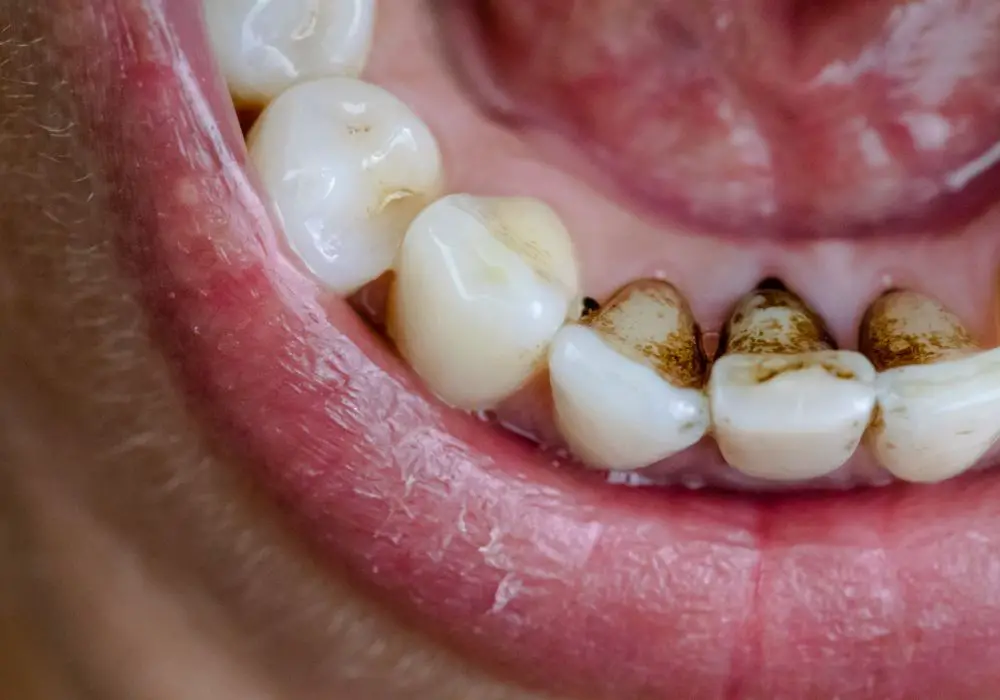
Mild discoloration or minor stains may often be managed simply through routine dental cleanings every 6 months along with diligent daily brushing and flossing. Avoiding heavily pigmented food and drinks can also help curb staining.
However, blackened regions between teeth or other worrisome color changes usually warrant prompt dental attention for further evaluation. Seeing a dentist right away is recommended if:
- Stains seemed to appear suddenly out of nowhere
- The stains are worsening or spreading quickly
- Discoloration is accompanied by pain or sensitivity
- There are other accompanying symptoms like bad breath, puffy gums, gingival bleeding, or ginigival recession
- Teeth feel loose in their sockets
- Any oral lumps or sores are present
- Any known dental work like a filling or crown has dislodged
- Gums bleed excessively even with gentle brushing
- Medical conditions like diabetes or autoimmune disorders are present
These accompanying signs indicate potential dental infection, injury, or underlying systemic disease. Thus, the blackened areas between teeth should be examined and diagnosed by a dentist as soon as possible.
How Do Dentists Diagnose the Cause of Black Stains Between Teeth?
During a dental examination, the dentist first looks closely for any visible signs of tooth decay, dental fractures, gum recession, periodontal pockets, or defective restorations. They will also thoroughly probe beneath the gumline using a periodontal probe to check for pocket depth and tooth looseness.
X-rays of the full mouth may be taken to allow the dentist to examine below the surface for potential bone loss, abscesses, or other issues not visible superficially. This helps identify problems like infected root canals, cracks, or leaky dental work material that could be linked to the discoloration.
After completing a comprehensive oral health evaluation, the dentist can then perform additional diagnostic tests aimed at uncovering the exact source of stain formation between teeth. This may potentially involve:
- Saliva testing – A saliva sample is evaluated for elevated levels of bacteria that produce pigmented compounds responsible for blackish stains.
- Plaque staining – This includes applying a disclosing solution to the teeth which stains any plaque buildup red so that pigmented areas are easier to identify.
- Transillumination – The dentist shines a bright curing light through the tooth to uncover any internal stains originating within the deeper tooth structure.
- Photographic monitoring – Tracking stain progression through a series of dated clinical photographs. Comparisons allow the dentist to determine if stains are worsening or spreading.
With the information gathered, an accurate determination can be made regarding what is causing the blackened areas that have developed between teeth. Then appropriate treatment measures can be initiated.
Available Treatment Options for Black Tooth Staining
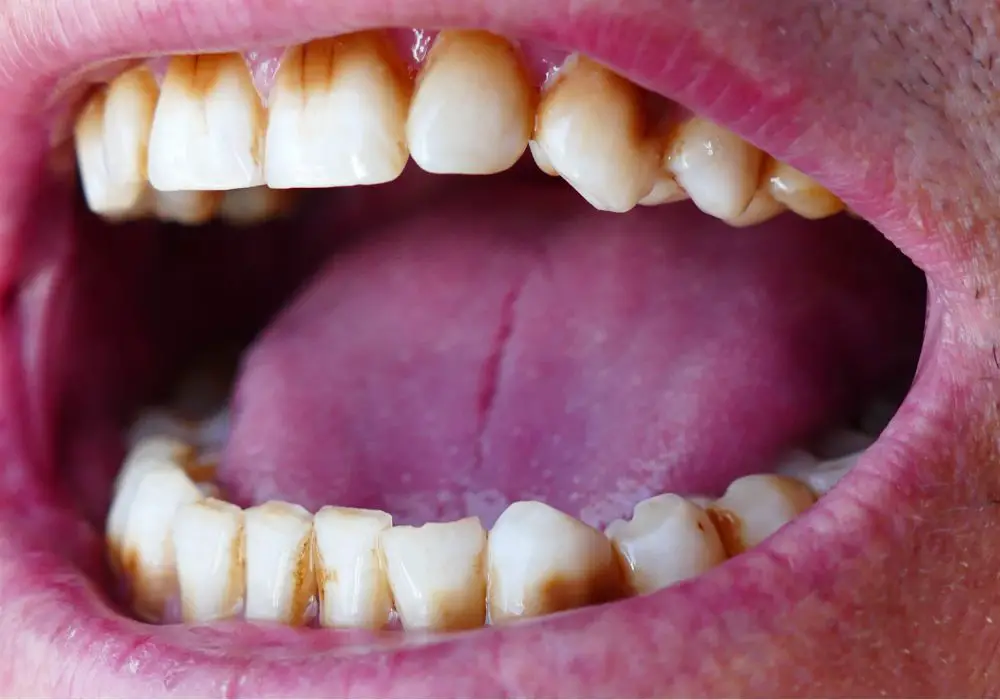
The precise treatment recommended depends on the source of the tooth discoloration after the dentist makes a diagnosis. Common treatment approaches can include:
Professional Dental Cleaning
Often, a routine professional teeth cleaning is sufficient for extrinsic stains caused by foods, drinks, tobacco, or poor oral hygiene. The dental hygienist will thoroughly remove all surface stains, plaque, and calculus deposits above and below the gumline using scaling instruments and polishing tools.
For particularly stubborn nicotine or tobacco tar stains, the hygienist may need to use an ultrasonic scaler to vibrate the deposits off. This specialized tool helps demineralize and disrupt tenacious buildup that is then suctioned away.
Whitening Procedures
In-office whitening, take-home trays from the dentist, or dentist-supervised use of bleaching strips/gel can all help brighten and remove intrinsic blackish staining within the tooth enamel. However, any defective restorations or active decay must first be repaired to avoid tooth sensitivity issues.
Dental Restorations
Replacing defective filling material, cracked teeth, faulty crowns, and corroded or leaking dental work removes associated staining.Cosmetic bonding, veneers, or crowns can also mask stained areas with a more natural, uniform tooth color. Your dentist can discuss restorative options to refresh your smile.
Preventive Measures
Daily brushing and flossing along with regular professional dental cleanings every 6 months will help curb additional staining. Reducing consumption of acidic and pigmented foods and beverages also helps prevent compounds that promote discoloration from adherence to the enamel.
Treatment of Periodontal Disease
If gum infections are causing the blackened areas between teeth, the infected gum tissue needs professional treatment. This may include deep cleanings, antimicrobials, and periodontal surgery to reduce periodontal pockets harboring staining bacteria.
Following the recommended treatment protocol from your dentist and maintaining excellent oral hygiene at home will keep the teeth looking their whitest. It is also important to follow up on any referrals you may receive, such as for root canal therapy, orthodontic evaluation, or biopsy with an oral pathologist. Identifying and addressing the underlying problem remains the key to preventing recurrent issues with tooth discoloration.
Frequently Asked Questions
What causes black stuff to get in between teeth?
The leading causes of black material developing between teeth include dense plaque and calculus buildup, food/drink stains, tobacco use, defective dental work, trauma, medications, periodontal disease, and certain medical conditions. Chromogenic bacteria can blacken the biofilm between teeth.
Why would a tooth turn black?
Teeth generally turn black due to a penetrating stain into the inner tooth layers, decay, pulp necrosis, or trauma causing blood products to leak internally into the dentin tubules. This can also happen following certain dental procedures if enamel is thinned or dentin tubules exposed.
Is it normal for teeth to turn black as you age?
Some gradual darkening of teeth color is natural with aging as enamel thins and the yellowish-white dentin underneath shows through more. But distinct blackened areas or spots that develop on teeth are NOT a normal part of the aging process and should be evaluated.
Can teeth be stained black permanently?
Deep intrinsic stains that permeate the enamel and dentin under the surface can be exceedingly difficult to remove and may persist as a permanent discoloration without aggressive intervention. However, extrinsic black stains on the outer enamel surface can usually be removed through professional cleaning and whitening.
What is the black line on my teeth near the gums?
Black lines near the gum margins, also called gingival tattooing or black triangle decay, are typically indicative of periodontal disease. The pigmented bacterial byproducts stain the tooth edge. Tobacco use can also cause black lines to form. See a dentist.
How can I prevent my teeth from turning black?
Practicing excellent oral hygiene and getting regular dental cleanings helps prevent heavy staining. Reducing consumption of staining foods/drinks and avoiding tobacco also lowers your risk. See the dentist promptly if you notice any unusual tooth color changes for diagnosis and treatment.
Conclusion
Discovering that your teeth are turning black or dark in color anywhere, but especially between them, can certainly be worrisome. However, many possibilities exist ranging from dietary habits to dental disease. The good news is that most causes of blackened areas on teeth can be managed or reversed with professional dental care. Practicing ongoing prevention and requesting prompt evaluation of any unusual tooth staining will keep your smile looking its whitest.


